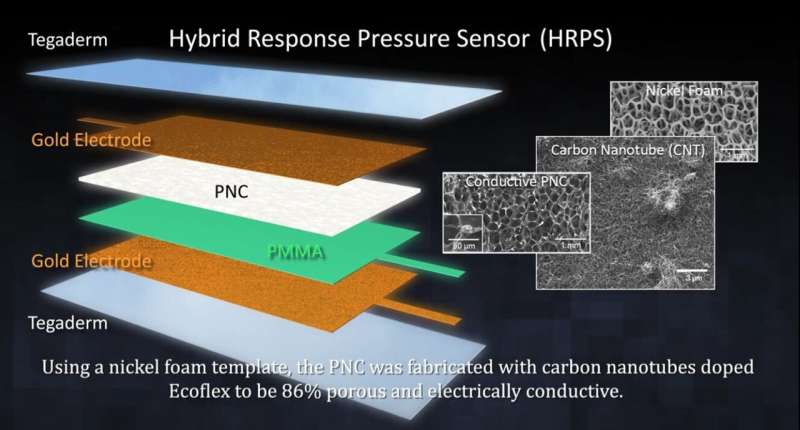
Medical sensing technology has taken great strides in recent years, with the development of wearable devices that can track pulse, brain function, biomarkers in sweat and more. However, there is one big problem with existing wearable pressure sensors: Even the slightest amount of pressure, something as light as a tight long sleeve shirt over a sensor, can throw them off track.
Texas engineers have solved this problem, which has been vexing the field for years now. And they did it by innovating a first-ever hybrid sensing approach that allows the device to possess properties of the two predominant types of sensors in use today.
"The field of flexible pressure sensors is extremely crowded, and after two decades we hit a bottleneck because no one could solve the tradeoff between pressure and sensitivity," said Nanshu Lu, an associate professor in the Department of Aerospace Engineering and Engineering Mechanics and the corresponding author of the new research published today in Advanced Materials. "This is the first sensor able to leverage a new hybrid mode to withstand pressure without a significant decay in sensitivity."
Soft pressure sensors today are generally made of three layers—a deformable sensing layer sandwiched in between a pair of electrodes. These sensors generally fall into one of two categories—piezo-capacitive and piezo-resistive.
Lu's team utilized an electrically conductive and highly porous nanocomposite as the sensing layer and added an extra insulating layer to the sensor, which gave it capabilities of both types of sensors. This new hybrid sensing is what allows it to better withstand pressure.
Typical sensors experience a 10-fold decline in sensitivity when experiencing any pressure beyond a slight touch. This sensor, applied to a test subject's forehead, was able to withstand the pressure of a tight-fitting virtual reality headset on top of it with only a minimal loss in sensitivity. Pressure can not only cause a loss of accuracy in many sensors, but it can blunt the ability to deliver a reading at all.
"As we apply external pressure, the sensitivity drops, but is still on par with other sensors at zero pressure," said Lu, who also has appointments in the Department of Electrical and Computer Engineering, Walker Department of Mechanical Engineering, Department of Biomedical Engineering and UT Austin's Texas Materials Institute.
Lu has long been a pioneer in this sensing field, primarily through her electronic tattoo technology—a series of devices that are so lightweight and stretchable that they can be placed over the heart, the brain, or the muscle for extended periods with little or no discomfort.
But, Lu has even grander visions for these sensors and e-tattoos. She is working on ways to allow the sensor material to be wrapped around almost any object and give it the sensitivity of human skin. The most obvious application is wrapping it around robotic hands and fingers to give them the ability to recognize objects by touching them. But there are many other things it could do.
"The applications could be unlimited," Lu said. "Stretchable, e-skin could be wrapped around almost any object."
Explore further
Citation: Soft pressure sensor breakthrough solves field's most challenging bottleneck (2021, September 28) retrieved 28 September 2021 from https://ift.tt/3ESPmDQ
This document is subject to copyright. Apart from any fair dealing for the purpose of private study or research, no part may be reproduced without the written permission. The content is provided for information purposes only.
"soft" - Google News
September 29, 2021 at 03:38AM
https://ift.tt/3ESPmDQ
Soft pressure sensor breakthrough solves field's most challenging bottleneck - Phys.org
"soft" - Google News
https://ift.tt/2QZtiPM
https://ift.tt/2KTtFc8
Bagikan Berita Ini














0 Response to "Soft pressure sensor breakthrough solves field's most challenging bottleneck - Phys.org"
Post a Comment